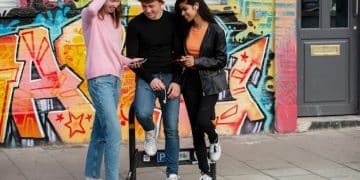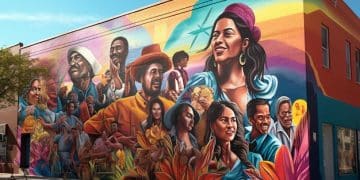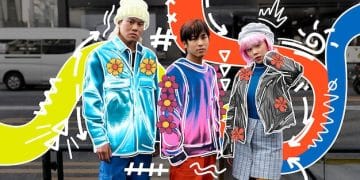Streetwear and Art: Where Fashion Meets Visual Expression
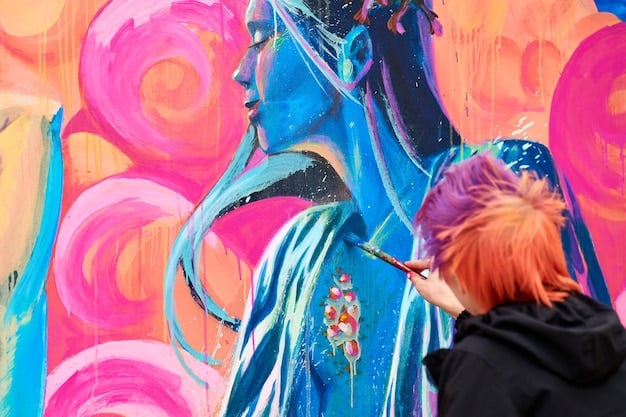
The dynamic interplay between streetwear and art transcends mere aesthetics, forging a unique canvas where fashion becomes a powerful medium for visual expression, cultural commentary, and a reflection of urban life’s raw creativity.
In the evolving landscape of contemporary style, the seamless fusion of streetwear and art: exploring the intersection of fashion and visual expression has carved out a distinctive niche. This connection is more than a fleeting trend; it represents a profound partnership where clothing transcends utilitarian purpose, becoming a vibrant medium for storytelling, social commentary, and artistic innovation. This article delves into how these two powerful forces converge, creating a cultural phenomenon that reshapes global aesthetics and influences how we perceive both art and fashion.
The Genesis: How Streetwear Became a Cultural Canvas
Streetwear’s origins are deeply rooted in counter-culture movements of the late 20th century, emerging from skate, surf, hip-hop, and punk scenes. It defied traditional fashion norms, prioritizing comfort, authenticity, and individuality over haute couture’s exclusivity. This rebellious spirit inherently fostered a connection to various art forms that also thrived outside mainstream institutions.
Initially, this connection was organic. Graffiti artists adorned city walls, and their visual language naturally found its way onto t-shirts and hoodies worn by their communities. Musicians used fashion to express their identity, and streetwear became a uniform for rebellion. This early adoption of art within fashion was not about high concept; it was about raw, unfiltered expression, creating a visual dialogue between creators and their audience.
From Subculture to Global Phenomenon
What began as niche sartorial expressions rapidly gained traction, propelled by the accessibility of screen printing and the increasing influence of music and youth culture. Brands like Stüssy and Supreme, born from these subcultures, understood that their clothing was more than just apparel; it was a statement, a piece of wearable art that signified belonging and attitude.
- Early Influencers: Skaters, surfers, and musicians were the initial adopters, popularizing casual yet distinct styles.
- DIY Ethos: Screen printing and customisation allowed for unique artistic expressions to be directly translated onto garments.
- Brand Storytelling: Pioneering streetwear brands built narratives around their collections, often collaborating with underground artists.
The transition from a subcultural uniform to a global fashion powerhouse was marked by strategic collaborations and a growing appreciation for its democratic appeal. As celebrities and mainstream media embraced streetwear, its artistic potential became undeniable, inviting a broader range of artists and designers to engage with its dynamic platform.
Evolving Artistic Partnerships
The symbiotic relationship evolved as streetwear matured. No longer confined to mere graphic tees, brands began to incorporate more sophisticated artistic techniques and concepts. This included bespoke embroidery, intricate textile designs, and the use of garments as three-dimensional sculptures. The boundary between fashion design and fine art started to blur, creating innovative outcomes.
The early 2000s saw a surge in streetwear brands actively seeking out contemporary artists for collaborations, moving beyond individual graphic designers to encompass acclaimed painters, sculptors, and even performance artists. This strategic alliance elevated both fields, granting artists new platforms for their work and imbuing streetwear with deeper artistic integrity.
The Canvas of the City: Graffiti, Street Art, and Fashion’s Embrace
At the very heart of the connection between streetwear and art lies the urban landscape itself. Graffiti and street art, born in the same concrete jungles that fostered streetwear, share a common ethos of challenging conventions and making art accessible. This shared DNA made their integration into fashion almost inevitable, creating a powerful visual language recognized worldwide.
Graffiti’s bold lines, vibrant colors, and thematic urgency translated effortlessly onto apparel. It offered designs that were instantly recognizable yet deeply subversive. Streetwear designers began to view garments not just as clothing, but as portable canvases, allowing wearers to carry a piece of the rebellious and creative energy of the streets with them.
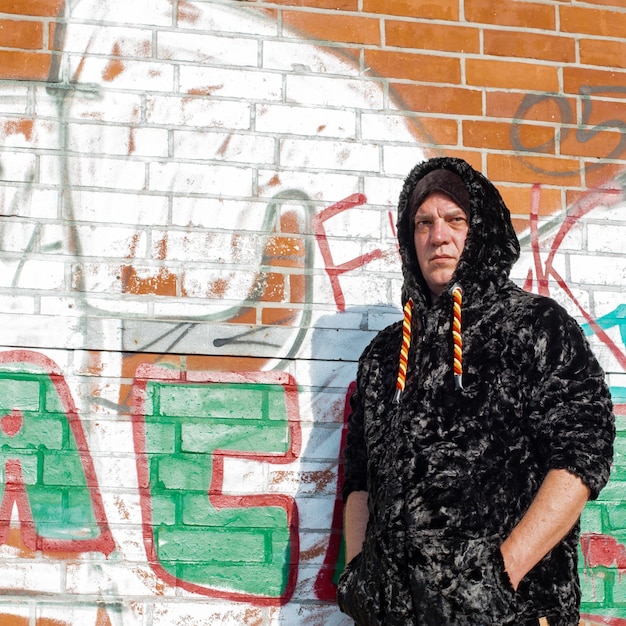
Iconic Art-Inspired Collections
Many landmark collections in streetwear history have drawn direct inspiration from or directly featured the works of prominent street artists. These collaborations extended beyond mere reproduction; they often involved artists creating original pieces specifically for the apparel, making each garment a unique extension of their artistic vision.
Consider the impact of artists like KAWS, Shepard Fairey (OBEY), and Futura 2000. Their distinct visual styles, initially recognized in galleries and on walls, became central to hugely successful streetwear collections. These partnerships allowed the art to reach a mass audience, while giving the fashion an undeniable sense of cultural authenticity and artistic weight.
- KAWS Collaborations: His distinct “X” eyes and companion figures have appeared on countless apparel items, bridging fine art with mass consumer culture.
- Shepard Fairey’s OBEY: Directly incorporates his iconic graphic design and activist art into a globally recognized streetwear brand.
- Futura 2000’s Abstract Graffiti: His dynamic, abstract spray paint compositions have graced limited-edition clothing, showcasing the fluidity of art across mediums.
This integration reflects a broader trend where the accessibility of urban art meets the global reach of fashion. It democratizes art, transforming exclusive gallery pieces into wearable statements that anyone can own and display. The reciprocal influence means that as streetwear evolves, so too does the public perception and appreciation of street art as a legitimate and powerful artistic form.
Beyond Graphics: Streetwear as Performance Art and Self-Expression
The relationship between streetwear and art extends far beyond two-dimensional graphics. Streetwear itself can be seen as a form of performance art, where individuals curate their appearance as a deliberate act of self-expression. Each outfit chosen, each accessory donned, contributes to a narrative, transforming the wearer into a walking, talking gallery of their own identity.
In this context, the streets become the stage, and everyday life becomes the performance. The wearer becomes both the artist and the artwork, demonstrating how personal style can communicate complex ideas, allegiances, and attitudes without uttering a single word. This inherent theatricality resonates deeply with various artistic disciplines, particularly those focused on identity and public engagement.
Deconstructing the “Wearable Art” Concept
The concept of “wearable art” is not new, but streetwear has recontextualized it within a contemporary urban setting. It’s not about impractical, avant-garde haute couture; it’s about everyday garments imbued with artistic intent. This shift makes art more approachable and relatable, democratizing its ownership and display.
Designers often utilize unconventional materials, experimental silhouettes, and unique construction methods to elevate streetwear beyond basic apparel. This pushing of boundaries mirrors artistic experimentation, challenging viewers to reconsider what constitutes “fashion” and what constitutes “art.”
The very act of dressing in streetwear becomes a form of artistic curation. Individuals meticulously select pieces, combine textures and colors, and accessorize to create a cohesive aesthetic that reflects their values, influences, and current mood. This careful assembly is akin to an artist composing a piece, with each element playing a crucial role in the overall effect.
The Influence of Haute Couture and Fine Art on Streetwear
While streetwear traditionally emerged from counter-culture, its undeniable impact on mainstream fashion has led to a fascinating reversal of influence. Haute couture, once seen as entirely separate, now frequently draws inspiration from streetwear aesthetics, often incorporating elements of its comfort, utility, and urban cool. This cross-pollination further blurs the lines, elevating streetwear’s artistic standing.
High fashion brands have embraced collaborations with streetwear labels and artists, recognizing the cultural cachet and innovative spirit they bring. This strategic alignment highlights how streetwear’s artistic roots are enriching the broader fashion ecosystem, introducing new visual languages and challenging traditional notions of luxury.
Collaborations Between High Fashion and Streetwear
The past decade has seen an unprecedented number of collaborations between historically distinct realms. Louis Vuitton’s seminal partnership with Supreme, for instance, was a watershed moment, proving that streetwear’s perceived “exclusivity through scarcity” could merge seamlessly with luxury’s established heritage.
- Louis Vuitton x Supreme: A landmark collaboration that brought streetwear credibility to high fashion and vice versa, creating unparalleled hype.
- Dior x KAWS: This collaboration infused Dior’s refined aesthetic with KAWS’ playful, contemporary art figures, appealing to a new generation of luxury consumers.
- Nike x Off-White: Virgil Abloh’s deconstructive approach to iconic Nike silhouettes through Off-White introduced a new artistic and intellectual dimension to athletic wear.
These partnerships demonstrate a mutual respect for creative innovation. High fashion gains an injection of relevancy and contemporary edge, while streetwear receives validation and resources to push its artistic boundaries even further. This dynamic exchange ensures that both fields continue to evolve, learning from each other’s strengths.
Art as Inspiration for Fabric and Form
Beyond direct graphic reproductions, fine art informs streetwear designers in more subtle ways. Abstract expressionism can inspire garment asymmetry or unconventional dye treatments. Sculpture can influence textile manipulation and three-dimensional silhouette creation. The history of art provides an endless wellspring of ideas for innovation in cut, fabric, and embellishment.
Designers might look to minimalist art for clean lines and understated elegance, or to surrealism for unexpected juxtapositions and thought-provoking patterns. This conceptual translation of artistic principles into tangible garments demonstrates a deeper understanding of art’s fundamental elements – color, form, texture, and composition – applied to the wearable medium.
Streetwear and Digital Art: The Metaverse, NFTs, and Beyond
As the digital frontier expands, streetwear’s dialogue with art finds new dimensions, particularly in the realm of NFTs (Non-Fungible Tokens) and the metaverse. These virtual spaces offer unprecedented opportunities for artistic expression within fashion, pushing the boundaries of what a “garment” can be and how art can be consumed.
Digital artists are creating virtual clothing lines, often in collaboration with established streetwear brands, allowing users to dress their avatars in unique, tokenized pieces. This not only opens up new revenue streams but also provides a canvas for designs that defy the limitations of physical reality, embracing outlandish forms and impossible textures.
NFTs as Wearable Art Assets
NFTs have revolutionized ownership in the digital space, and streetwear has quickly adopted this technology. Digital garments, often designed by renowned artists, are sold as NFTs, providing verifiable proof of ownership in virtual worlds. This means that a rare digital hoodie can hold as much, if not more, value than its physical counterpart.
- Unique Digital Collectibles: NFTs secure the scarcity and authenticity of virtual clothing, making them highly desirable.
- Metaverse Fashion Shows: Brands are hosting entirely digital fashion shows, showcasing virtual collections that only exist in the metaverse.
- New Artistic Mediums: Designers and artists are experimenting with generative art, animation, and interactive elements directly embedded into digital garments.
This integration of NFTs into streetwear not only creates new consumption models but also expands the definition of “art.” It positions fashion as a leading force in exploring how digital assets can function as cultural commodities and artistic statements, allowing for creative freedom unconstrained by physical limitations.
The Metaverse as a New Fashion Frontier
The metaverse, a collective virtual shared space, is becoming a significant avenue for streetwear’s artistic evolution. In these immersive environments, users express themselves through highly customizable avatars, and digital fashion is paramount. Streetwear brands are leveraging this to create unique virtual experiences and products.
The metaverse allows for experimental designs that wouldn’t be possible in the physical world – cloaks that shimmer with impossible light, shoes that defy gravity, or patterns that morph based on user interaction. This provides a limitless canvas for designers to explore artistic concepts, unburdened by material constraints or traditional manufacturing processes.
The Sociopolitical Statement: Art, Activism, and Streetwear
Beyond aesthetics, the intersection of streetwear and art frequently serves as a powerful platform for sociopolitical commentary and activism. Both fields have historically been used to express dissent, highlight social issues, and foster community, making their convergence a potent force for change. This aspect underscores streetwear’s authenticity and its deep roots in grassroots movements.
Artists use their designs on garments to convey powerful messages about inequality, environmental concerns, human rights, and political landscapes. This turns everyday clothing into a walking billboard, allowing the wearer to align themselves with a cause and participate in a visual dialogue without uttering a word. It’s subtle yet profoundly impactful.
Designers as Social Commentators
Many influential streetwear designers view their work as more than just fashion; they see it as a vehicle for social commentary. Brands often release collections or specific pieces that directly address current events, historical injustices, or future aspirations. This approach elevates the clothing from mere commodity to a meaningful artifact.
For example, designs might incorporate symbols of resistance, protest slogans, or imagery related to specific social movements. The choice of graphics, typography, and color palette is deliberate, aimed at evoking strong emotions or sparking necessary conversations. This engagement transforms the act of getting dressed into an active form of civic participation.
This commitment to social commentary harkens back to art’s ancient role as a mirror of society. By embedding powerful messages in garments, streetwear ensures that these conversations are not confined to galleries or academic spaces, but are actively worn and displayed in daily life, reaching a diverse audience.
Art as a Catalyst for Change through Fashion
The collaborative projects between artists and streetwear brands on social issues are particularly impactful. They leverage the artist’s visual voice and the brand’s reach to amplify important messages. This often results in limited-edition drops where proceeds benefit charitable organizations, transforming consumption into a direct act of giving.
Consider the numerous instances where streetwear brands have collaborated with artists to raise awareness for causes like climate change, racial justice, or mental health. These collections often sell out rapidly, indicating not just consumer desire for unique items but also a public appetite for fashion that stands for something meaningful.
The accessibility of streetwear means these messages penetrate broader demographics than traditional art forms often can. It empowers individuals to wear their beliefs, becoming advocates simply by donning a t-shirt or hoodie. This makes the intersection a vibrant, living testament to fashion’s capacity for cultural impact and social transformation.
The Future of Wearable Art: Continued Evolution of Streetwear
The trajectory of streetwear and art: exploring the intersection of fashion and visual expression suggests a continued, dynamic evolution. As technology advances and cultural boundaries blur further, the ways in which fashion serves as a canvas for artistic expression will only become more sophisticated and integrated. We are likely to see even deeper explorations into interactive and sustainable art within clothing.
The future might include garments that react to their environment, displaying dynamic art through embedded screens or color-changing fibers. Augmented reality experiences linked to clothing could bring digital artworks to life on the wearer, creating an interactive show for onlookers. The possibilities are truly boundless.
Innovation in Materials and Technology
Technological advancements in textiles and manufacturing are opening new frontiers for wearable art. Smart fabrics can integrate sensory capabilities, allowing clothing to respond to touch, sound, or even mood. This creates an entirely new medium for artists to explore, moving beyond static imagery to dynamic, interactive experiences.
Innovations like 3D printing and digital weaving allow for unprecedented complexity in form and texture, pushing the boundaries of traditional garment construction. This means that designers can execute artistic visions that were once purely conceptual, turning clothing into true sculptural and technological marvels.
Sustainable practices are also becoming increasingly important, driving artists and designers to create art that is not only visually compelling but also environmentally responsible. This includes using recycled materials, natural dyes, and ethical production methods, embedding artistic values within the entire lifecycle of the garment.
Blurring Boundaries and Expanding Horizons
The trend of blurring boundaries between art, fashion, and technology is set to intensify. Future streetwear collections might be launched simultaneously in physical, digital, and gaming environments, complete with accompanying music, interactive installations, and virtual reality components. This holistic approach treats fashion as a multisensory artistic experience.
The next generation of artists and designers will likely possess hybrid skill sets, comfortably navigating painting, sculpture, graphic design, textile innovation, and coding. This multidisciplinary approach will lead to even more groundbreaking creations, cementing streetwear’s role as a leading edge of cultural and artistic innovation. The canvas is expanding, and the art is becoming ever more integral to the fabric of our lives.
| Key Point | Brief Description |
|---|---|
| 🎨 Cultural Canvas | Streetwear originates from subcultures, providing an authentic platform for artistic self-expression and community identity. |
| 🏙️ Urban Art Fusion | Deeply inspired by graffiti and street art, streetwear transforms garments into portable statements of urban creativity. |
| 🌐 Digital Expansion | Embracing NFTs and the metaverse, streetwear explores new dimensions of wearable art in virtual spaces, pushing boundaries. |
| 🗣️ Sociopolitical Impact | Used as a powerful medium for activism and social commentary, reflecting global concerns and fostering meaningful dialogue. |
Frequently Asked Questions About Streetwear and Art
▼
Streetwear’s early associations with art stemmed from its roots in counter-cultures like skateboarding, surf, and hip-hop. These subcultures inherently embraced graphic elements from graffiti, album art, and protest posters, integrating them directly onto clothing. Designers often collaborated with local artists, blurring the lines between apparel and visual expression, fostering an organic connection that grew over time.
▼
The primary artistic influences on streetwear are graffiti and street art, known for their bold graphics and urban energy. However, it also draws inspiration from graphic design, pop art, abstract expressionism, and even fine art through museum collaborations. The appeal lies in incorporating diverse visual expressions, reflecting a wide range of movements and cultural contexts onto wearable pieces.
▼
Digital art and NFTs have significantly impacted streetwear by introducing virtual garments and collectibles in the metaverse. Brands now create exclusive digital apparel that can be owned as NFTs, allowing for artistic designs that defy physical limitations. This expands streetwear’s reach into virtual spaces, enabling new forms of expression and ownership, and broadening what “wearable art” can signify in a digital age.
▼
Yes, streetwear can certainly be viewed as a form of performance art. Individuals use their curated outfits to express identity, affiliations, and attitudes in public spaces. The act of choosing and styling clothes becomes a deliberate presentation of self, turning the urban environment into a stage and the wearer into both artist and artwork. This self-expression communicates narratives without words, engaging directly with an audience.
▼
The future of streetwear and art is poised for continued innovation, particularly with advancements in technology and sustainable practices. We can expect more interactive garments, augmented reality experiences tied to clothing, and deeper integration of digital art forms. The boundaries between fashion, art, and tech will further blur, leading to multidisciplinary creations and a more holistic, experiential approach to wearable art that impacts culture and society.
Conclusion
The convergence of streetwear and art is a compelling testament to fashion’s transformative power, demonstrating how clothing can transcend its functional role to become a profound medium of visual expression and cultural dialogue. From its grassroots origins intertwined with urban subcultures to its current influence on high fashion and its pioneering ventures into the digital realm, streetwear continually redefines the relationship between aesthetics and identity. It serves as a dynamic canvas for artists, allowing their visions to be worn and displayed, democratizing art, and reflecting the pulsing creativity of contemporary society. This enduring interplay ensures that streetwear remains a vibrant, evolving force, pushing boundaries and proving that true style is always a form of art.

